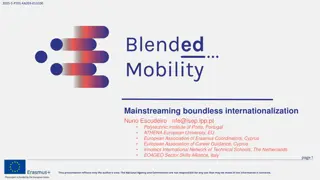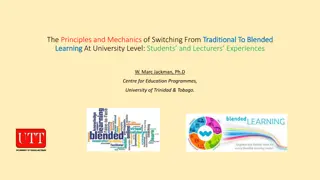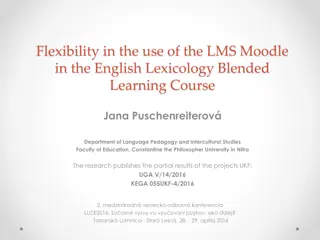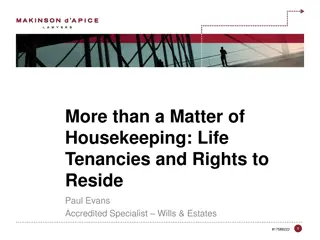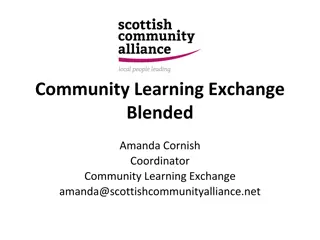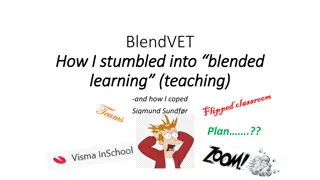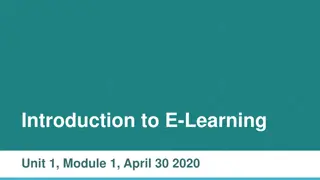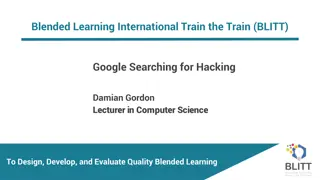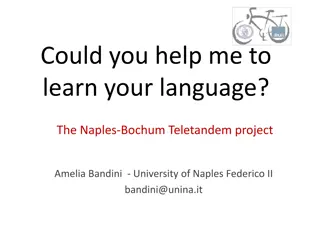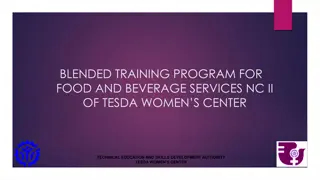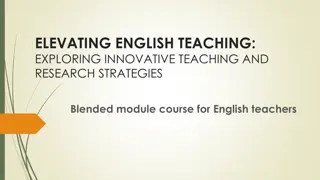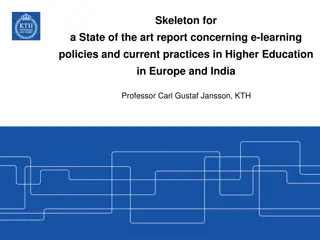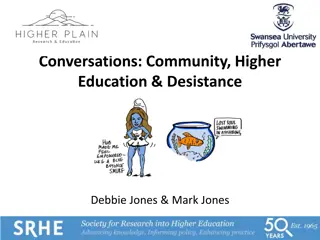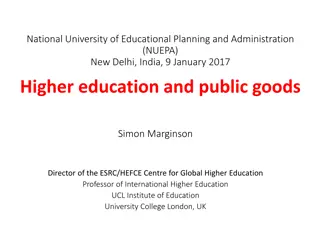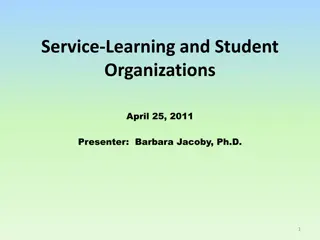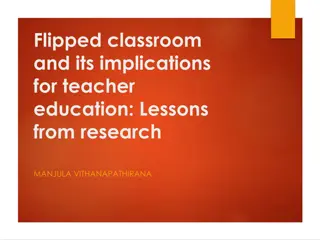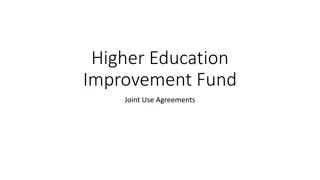Exploring Blended Learning in Higher Education
Blended learning combines face-to-face and technology-mediated teaching methods to enhance student learning outcomes. It involves various teaching practices such as debates, storytelling, and demonstration, leading to a thoughtful fusion of traditional and online learning experiences. Associated terms like Flipped Learning and Hybrid Learning offer additional insights into innovative educational approaches.
Download Presentation

Please find below an Image/Link to download the presentation.
The content on the website is provided AS IS for your information and personal use only. It may not be sold, licensed, or shared on other websites without obtaining consent from the author. Download presentation by click this link. If you encounter any issues during the download, it is possible that the publisher has removed the file from their server.
E N D
Presentation Transcript
Blended Learning Policy Prof Marmar Mukhopadhyay Educational Technology and Management Academy
Template 1. Blending 2. Learning 3. Blended Learning & Associated Terms 4. Blended Learning Policy 5. Blended Learning: Enabling Policies 6. Plan of Implementation 7. Conclusion National Blended Learning Policy in Higher Education
Blending First Acquaintance Blended Tea
Blending Learning not new Indian Gurukula and ancient Indian universities used a variety of teaching-learning practices, like: Listen-reflect-practice: (Sravan- Manan-Nididhyasana); Multichannel learning: Lecture, self-study, peer group learning, learning with experience, apply, teach, etc.; Debates and Argumentation (Vaad-Vivad-Vitarka); Question-Answer: Prashnottar vidhi; Imitation (Anukarana); Repetition and Rote Learning (Punaravritti); Explanation and Illustration (Vyaakhya- Drishtaanta vidhi); Demonstration and Practice (Pradarshana-abhayasa); Tour or Field Visits (Bhraman vidhi); Storytelling (Katha kathan).
Vaughan (2008): blended learning as a thoughtful fusion of face-to-face and online learning experiences. During the online and the technology-mediated components of these learning experiences, students are not required to be physically together in one place but may be connected digitally through online communities (Cleveland-Innes & Walton, 2018).
Blended learning, thus, is a blending of carefully chosen learning tactics from face-to- face and technology-mediated learning domains to achieve expected learning outcomes. Mukhopadhyay, 2022
A FEW ASSOCIATED TERMS In Flipped Learning, students learn in advance at home, followed by learning in the classroom. This sequencing has also been termed individual learning at home, followed by group learning in the classroom (Mukhopadhyay, 2022). In the Hybrid Learning model, a regular face-to-face classroom lecture is simultaneously streamed online. Hybrid learning as a mode of blended learning combines online educational materials with traditional in-class mechanisms.
HyFlex Learning combines the terms hybrid and flexible. In HyFlex courses, students can choose from one of three participation paths: Participate in face-to-face synchronous class sessions in-person (in a classroom) Participate in face-to-face class sessions via video conference (e.g., Zoom) Participate fully asynchronously via Course Works .
Research & Experimentatio n Multi-Channel Learning Direct Instruction Self-regulated Learning Basic Education Acquiring Knowledge Deepening Knowledge Creating Knowledge
Definition of Terms 1. Blended Learning 2. Flipped Learning 3. Hybrid Learning 4. HyFlex Learning 5. ETRE (Emergency Technology Response) 6. Webinar 7. Online Learning 8. ODL 9. MOOCs 10. OER 11. Six Models of Blended Learning National Blended Learning Policy in Higher Education
Blended Learning Models for Contextualisation Face-to- Face Driver Model Online Lab School Model Online Driver Model Flex Model Rotation Model Self-Blend Model Presentation title 11
Benefits of Blended Learning Increased synchronous & asynchronous interaction among peers & with teachers. Blended learning is more effective than either face- to-face or online learning. 1 7 Greater and progress at students own pace. independence opportunities 4 to Blended learning course Students perform better than F2F or online course students Develop digital skills necessary for evolving as lifelong self-learners. 2 8 Opportunity for peer and expert collaboration across countries and cultures. 5 Student satisfaction more in BL courses than in F2F lecture mode. It helps learners become virtual global citizens. Higher anytime, anywhere, self- pacing for learning. flexibility - 3 9 6 mastery Presentation title 12
National Infrastruct ure Institutional Infrastructu re Financial Provision Academic Leadership ENABLE RS Curriculum BLP ENABLE RS Student Readiness Learning Resources Teacher Readiness Learning Assessment
BL Policy Statements 1: India will adopt an ODL, and Online Integrated Blended System of Education 2: All Indian Educational Institutions will adopt Blended Learning in all Courses and subjects at all levels. 3: All students will learn to acquire, deepen and create knowledge. National Blended Learning Policy in Higher Education 14
Enabling Policies: National Infrastructure EP Fibre Fibre- -optic connect connect people institutions institutions dispersed dispersed locations optic Network Network will people and in in locations will be and all all educational educational remote remote villages villages be laid laid down down to to and and Presentation title 15
Enabling Policies: Institutional Infrastructure EP 1. Requisite ICT infrastructure will be developed in all education institutions 2. All teachers and students will have personal access to digital devices with Internet connectivity and at least 1.5 Mbps Internet speed (need advice) Presentation title 16
Enabling Policies: Curriculum EP 1. Curriculum will be reconstructed to align with the attributes of blended learning. 2. Every educational institutions will adopt blended programs, blended courses, and blended unit designs Presentation title 17
Enabling Policies: Learning Resources 1. High Quality Learning Resources in textual, video, games, animations, simulations, mobile apps, virtual labs will be made available online free of cost. 2. The online learning resources will be periodically reviewed and refreshed. 3. A National OER of digital contents, blended programs, courses, and unit designs will be created. EP Presentation title 18
Enabling Policies: Learning Assessment 1. The assessment system will be modified to best use blended learning; students will take online on-demand tests, collect micro-credentials, and benefit from the assurance-based credit scheme (read with art 24.4h). 2. Formative assessment will be adopted in all courses and programmes. 3. Technology-enabled on-demand learning assessment provision will be created EP Presentation title 19
Enabling Policies: Teacher Readiness All teachers will be trained in blended learning, All teachers will be trained in blended learning, and equipped with knowledge of the science of and equipped with knowledge of the science of human learning and equipped with necessary human learning and equipped with necessary ICT skills for implementing blended learning ICT skills for implementing blended learning Every institution and teacher will choose a Every institution and teacher will choose a Blended Learning Model to suit the context Blended Learning Model to suit the context EP 1. 1. 2. 2. Presentation title 20
Enabling Policies: Student Readiness EP 1. Students will be oriented about Blended Learning, its processes and benefits 2. Parents will be taken into confidence on implementing Blended Learning Presentation title 21
Enabling Policies: Academic Leadership 1. 1. All academic leaders will be oriented/trained in blended All academic leaders will be oriented/trained in blended learning, and equipped with knowledge of the science of learning, and equipped with knowledge of the science of human learning and the ICT skills necessary for human learning and the ICT skills necessary for implementing blended learning implementing blended learning 2. 2. Every institution will develop institutional plan of Every institution will develop institutional plan of implementation BLP, implement and create evidence implementation BLP, implement and create evidence with pilot/action with pilot/action 3. 3. Institutions will develop and follow a Theory of Change Institutions will develop and follow a Theory of Change to implement the BLP to implement the BLP EP Presentation title 22
Enabling Policies: Financial Provision EP There would be adequate financial support for adopting blended learning Presentation title 23
Challenges Magnitude of the System Wide diversity and Disparities Digital Divides Attitudes ICT Skills Deficiency Poor Access to Digital Devices Poor Internet Connectivity Presentation title 24
Conclusion Blended learning is the appropriate response for achieving the policy vision and developing education system. globally comparable NEP2020 has an implicit Blended Learning policy. The ingredients are strewn all over the document. There is need to stitch them logically together to create a comprehensive and meaningful Blended Learning Policy. Presentation title 25
Contact: marmar.mukhopadhyay@gmail.com Thank you



